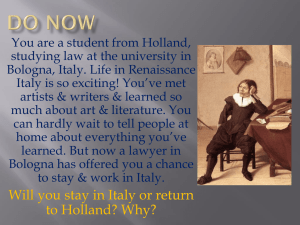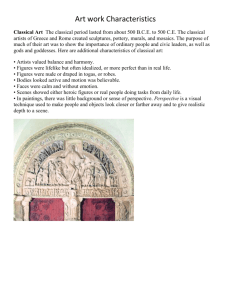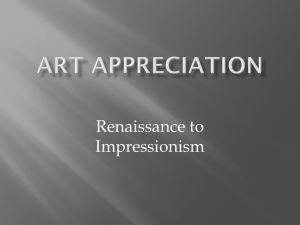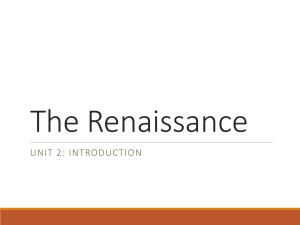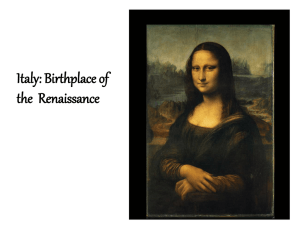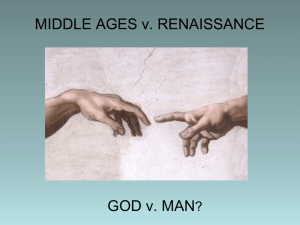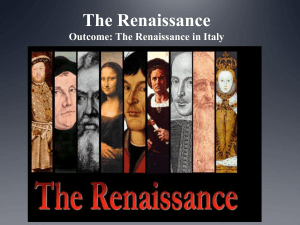Chapter 27 PowerPoint
advertisement
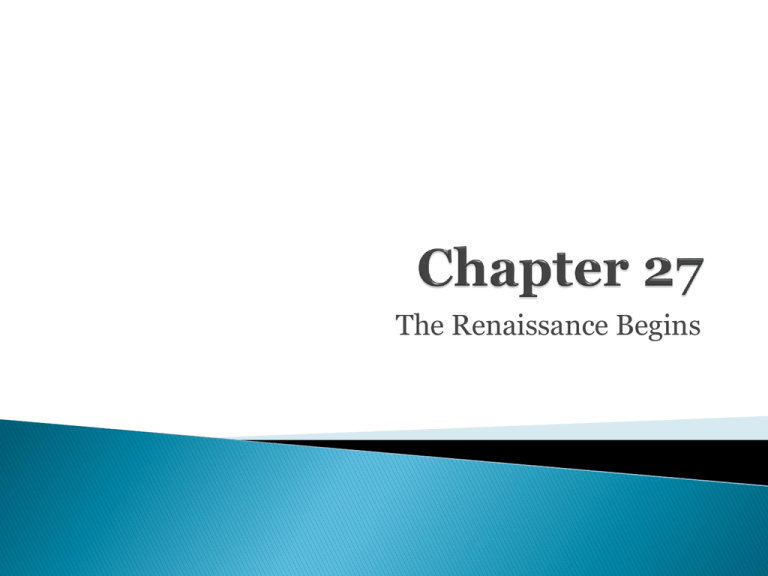
The Renaissance Begins What changes in Europe led to the Renaissance? Identify elements of classical, medieval, and Renaissance art. Connect the importance of the growth of towns, the rise of a money economy, and the development of independent city-states to the birth and spread of Renaissance ideas. Explore how humanism encouraged a new way of thinking that affected many aspects of European life during the Renaissance. Renaissance is a French word that means “rebirth.” The Renaissance period in Europe was from about 1300 to 1600. Considered to be an end to the darker Middle Ages. Remember… ◦ The middle ages in Europe were based on feudalism. ◦ The Roman Catholic Church encouraged people to think more about life after death than about daily life on Earth. ◦ Few people were educated. In the late Middle Ages… ◦ Trade and commerce increased ◦ Wealthy merchants and bankers supported the growth of arts and learning ◦ Renewed interest in the past sparked new creativity in architecture and new ways of thinking. Began in Italy in the 1300s and spread to other parts of Europe in the 1400s and 1500s. Renaissance: a great flowering of culture, based on classical Greek and Roman ideas and art, that began in Italy in the Late Middle Ages and spread throughout Europe. Classical Art: art influenced by the styles and techniques of ancient Greece and Rome. After the fall of Rome in the 5th century, the classical works were kept mostly by monks and members of the clergy. In the Late Middle Ages – merchants and Crusaders brought back some of these ideas from the East. People became very interested in these works and were inspired to create some of the literature and art of the Renaissance. Classical Art 500 BCE – 500 CE Artists created sculptures, pottery, murals and mosaics. Purpose of the art was to show the importance of ordinary people and civic leaders, as well as gods and goddessess.. Classical Art ◦ ◦ ◦ ◦ ◦ ◦ Artists valued balance and harmony Figures were lifelike – but more perfect than in real life. Bodies looked active and motion was believable Figures were nude or draped in togas Faces were calm and no emotion Scenes showed either heroic figures or real people doing daily life tasks ◦ Little background or sense of perspective Medieval Art 500 to 1300 CE Artists created stained glass windows, sculptures, illuminated manuscripts, paintings and tapestries. Purpose of art was to teach religion to people who could not read or write. Medieval Art ◦ Most art was religious, showing Jesus, saints and people from the Bible. ◦ Important figures in paintings were shown larger than others around them. ◦ Figures looked stiff, with little sense of movement ◦ Figures were fully dressed in stiff-looking clothing ◦ Faces were serious and showed little expression ◦ Painted figures looked two-dimension or flat ◦ Paint colors were bright ◦ Backgrounds were mostly one color, often blue or gold Renaissance Art 1300s to the early 1600s Artists created sculptures, murals, drawings, and paintings Purpose was to show the importance of people and nature, not just religious ideas Renaissance Art ◦ artists showed religious and nonreligious scenes ◦ Art reflected nature ◦ Figures were lifelike and three-dimensional – reflected new knowledge of anatomy ◦ Figures shown in action ◦ Figures were either nude or clothed ◦ Faces expressed what people were feeling ◦ Colors were shown responding to light ◦ Paintings were symmetrical, or balanced, with the right and left sides having identical elements ◦ Full backgrounds showed perspective, adding depth. Trade brought new ideas as well as good into Europe. Prosperous cities and new classes of people were created and people now had the wealth to support art and learning. 11th Century – Crusades strengthened contacts between western Europe and Byzantine and Muslim cultures 13th Century – Mongol conquests made the Silk Road to China safer Marco Polo explored trade routes from Italy to Europe, Africa and Asia Venice and Genoa in Italy were central trade hubs linking western Europe with the east. Trade ships carried goods to England, Scandinavia and Russia Middle Ages – barter system for goods Renaissance – people used coins to buy merchandise ◦ Coins came from all over and there money changers were developed to convert currency from one type to another. Resulted in craftspeople, merchants and bankers became more important in society. People who gained wealth through trade and commerce were able to make the cities more beautiful. Key Content Term City State – an independent state consisting of a city and its surrounding territory. Republic – a form of government in which citizens elect representatives to rule for them. In the Late Middle Ages – Italy had growing towns which developed into City-States. ◦ ◦ ◦ ◦ Conducted their own trade Collected their own taxes Made their own laws Power in the republic belonged to the people (or really – the rich merchants) Some city states became specialized ◦ ◦ ◦ ◦ Florence – center for cloth and banking Milan – metal goods and armor Genoa – port for ivory trade and gold from Africa Venice – had ships that controlled trade routes on the Mediterranean Sea These city states had a ton of wealth, and the rich families paid for statues, paintings, beautiful buildings and elegant avenues. They built new centers of learning – universities and hospitals. Key Content Terms: Humanism – a philosophy that tries to balance religious faith with an emphasis on individual dignity and an interest in nature and human society. Humanities – collectively, areas of study that focus on human life and culture, such as history, literature and ethics. Key Content Terms Individualism – the belief in the importance of an individual’s achievements and dignity. Humanism first came about in Italy as a result of the renewed interest in classical culture. One of the first Humanists was a man named Francesco Petrarch. ◦ Loved old books ◦ Created a large collection of ancient Latin and Greek texts that he made available to other scholars. Scholars traveled to Italy to learn about the new humanist ideas sparked by classical culture. They created a new way of looking at life ◦ The importance of the dignity of each individual ◦ Each person has the ability to control their own lives and achieve greatness (you were no longer stuck where you were born) ◦ Separated the state and its right to rule from the Church Humanist architects created buildings that had pillars, arches, and courtyards. Scholars began to teach methods of observation and experimentation Scientists proposed new ideas about the starts and planets These new ideas put humanist’s into conflict with the Roman Catholic Church. The Church still wanted people to believe that laws were made by God and that people who broke those laws were sinful. The Church wanted people to follow the rules and not question them. Humanists wanted people to think for themselves and question everything. What was the Renaissance? The Renaissance was a flowering of art and learning that was inspired by a rediscovery of the classical cultures of Greece and Rome. It began in Italy around 1300 and spread throughout Europe, lasting to the early 1600s. The Growth of Trade and Commerce Italy’s location made it a perfect crossroads for trade between Europe and Asia, which began to increase at this time. This growth of trade and commerce created prosperous cities and classes of people with enough wealth to support education and the arts. The Influence of Italian City States The developing wealth and power of the individual Italian city-states helped to promote and spread Renaissance ideas. Civic leaders and wealthy private individuals paid for new works of art and built new centers of learning. The Growth of Humanism The new philosophy of humanism spurred interest in learning and fresh ways of thinking. Humanist, such as Francesco Petrarch, sought to balance religious faith with an emphasis on individualism, the workings of the natural world, and human society. The sought to separate the workings of government from the Church.


